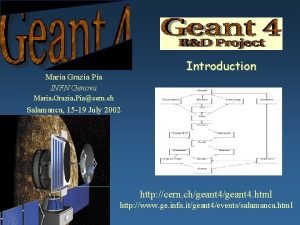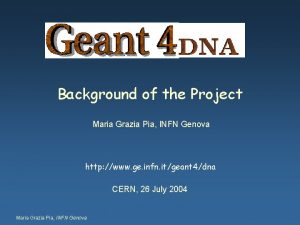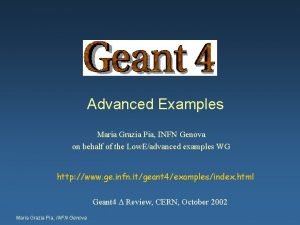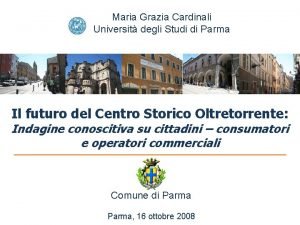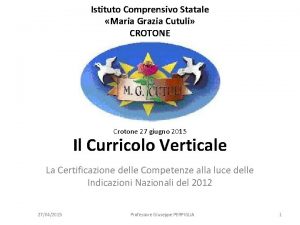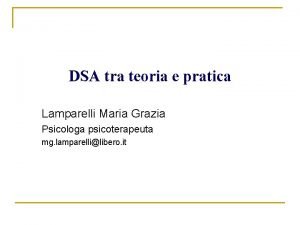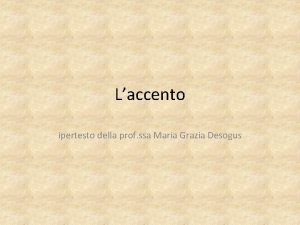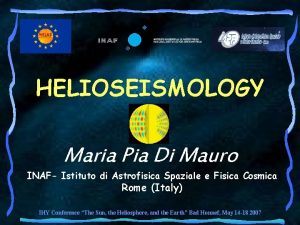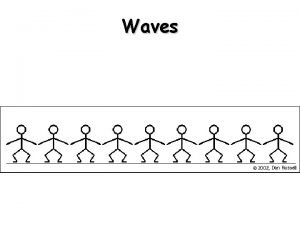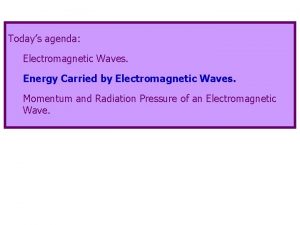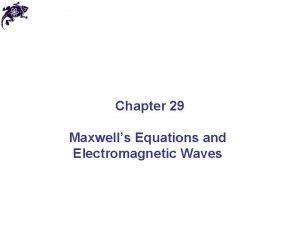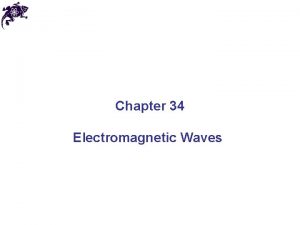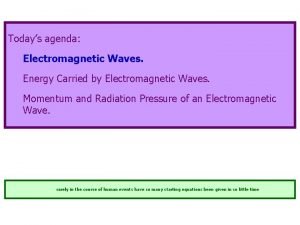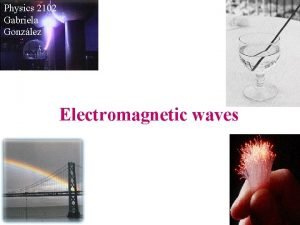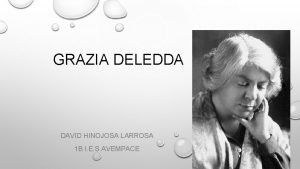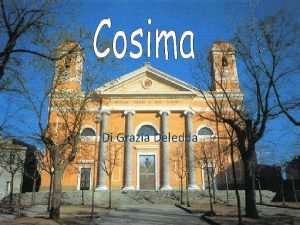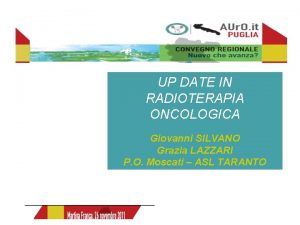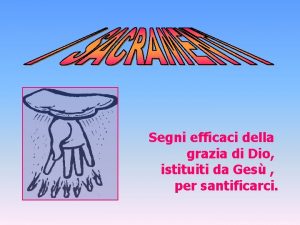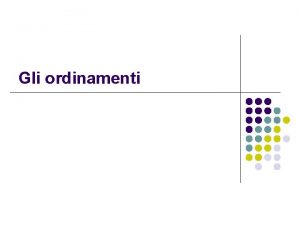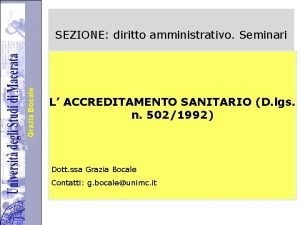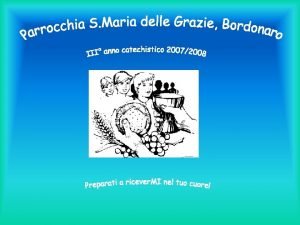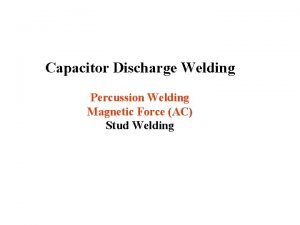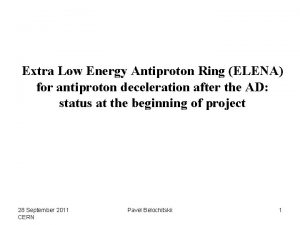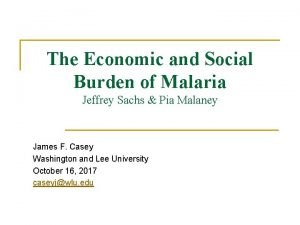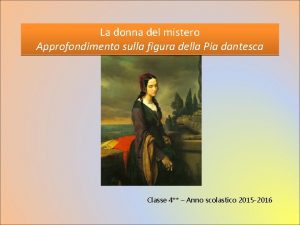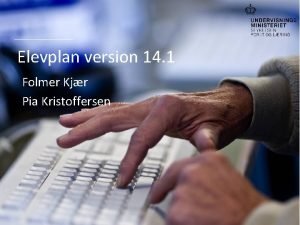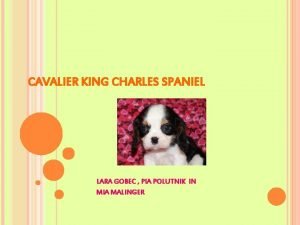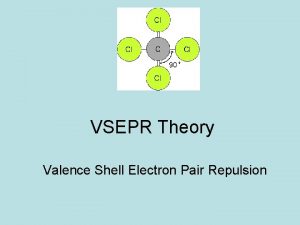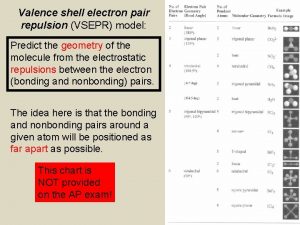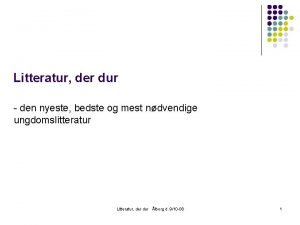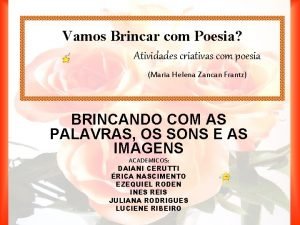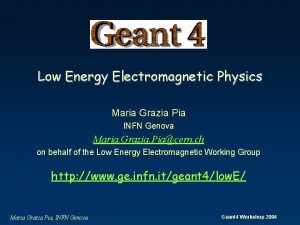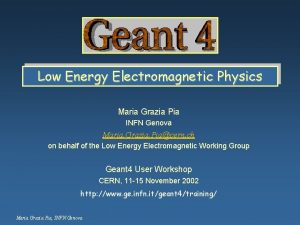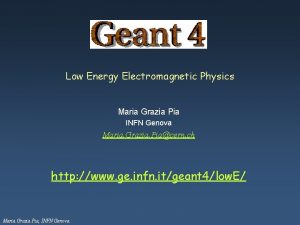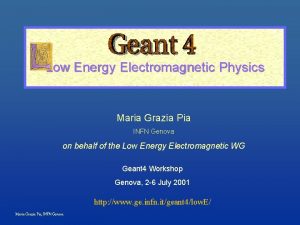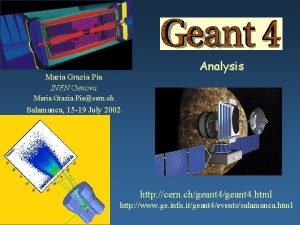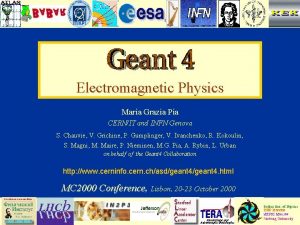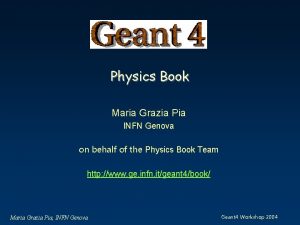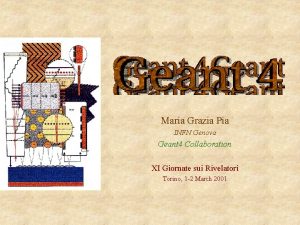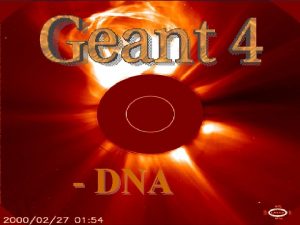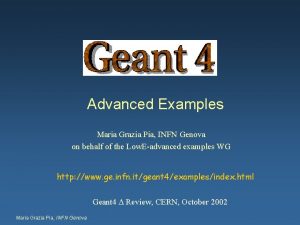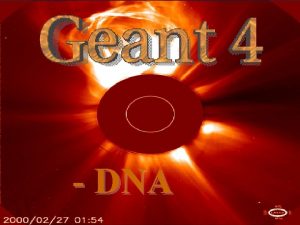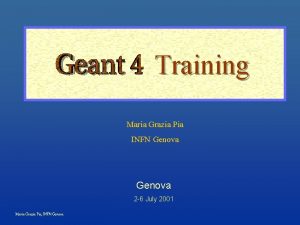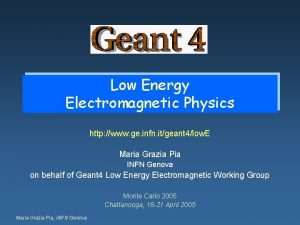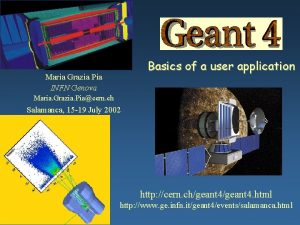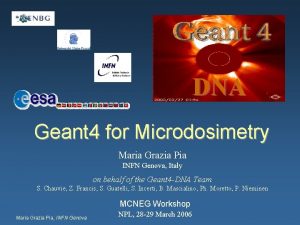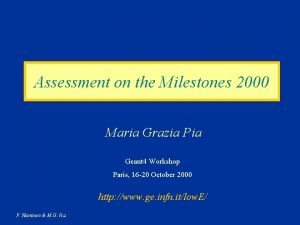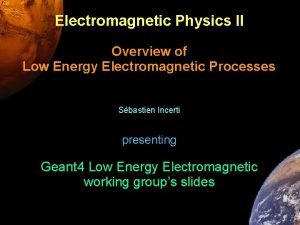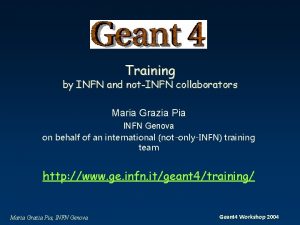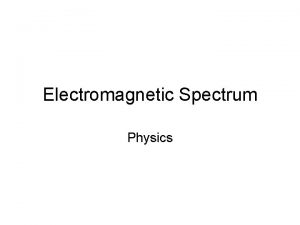Low Energy Electromagnetic Physics Maria Grazia Pia INFN













![Rayleigh scattering Angular distribution: F(E, q)=[1+cos 2(q)] F 2(q) – where F(q) is the Rayleigh scattering Angular distribution: F(E, q)=[1+cos 2(q)] F 2(q) – where F(q) is the](https://slidetodoc.com/presentation_image_h/33b02577adf619fa6c319cdddfe4a9f5/image-14.jpg)













































- Slides: 59

Low Energy Electromagnetic Physics Maria Grazia Pia INFN Genova Maria. Grazia. Pia@cern. ch on behalf of the Low Energy Electromagnetic Working Group Geant 4 Workshop Helsinki, 30 31 October 2003 http: //www. ge. infn. it/geant 4/training/ Maria Grazia Pia, INFN Genova

Plan of the tutorial Part 1 Overview Software process OOAD Part 2 How to use Low. E processes Examples Some experimental applications Outlook Physics – – Electrons and photons Hadrons and ions Atomic relaxation Polarisation Maria Grazia Pia, INFN Genova

What is A package in the Geant 4 electromagnetic package – geant 4/source/processes/electromagnetic/lowenergy/ A set of processes extending the coverage of electromagnetic interactions in Geant 4 down to “low” energy – 250 e. V (in principle even below this limit)/100 e. V for electrons and photons – down to the approximately the ionisation potential of the interacting material for hadrons and ions A set of processes based on detailed models – shell structure of the atom – precise angular distributions Complementary to the “standard” electromagnetic package – will learn more on domains of application in the second lecture Maria Grazia Pia, INFN Genova

Overview of physics Compton scattering Rayleigh scattering Photoelectric effect Pair production In progress – More precise angular distributions (Rayleigh, photoelectric, Bremsstrahlung etc. ) – Polarised g conversion, photoelectric Bremsstrahlung Ionisation in two “flavours” of models: Polarised Compton • based on the Livermore Library • à la Penelope + atomic relaxation – fluorescence – Auger effect following processes leaving a vacancy in an atom Maria Grazia Pia, INFN Genova Development plan – Driven by user requirements – Schedule compatible with available resources

Overview of physics Compton scattering Rayleigh scattering Photoelectric effect Pair production In progress – Polarised g conversion, photoelectric – More precise angular distributions (Rayleigh, photoelectric, Bremsstrahlung etc. ) Bremsstrahlung Ionisation Foreseen Polarised Compton + atomic relaxation – fluorescence – Auger effect following photoelectric effect and ionisation Maria Grazia Pia, INFN Genova – New models, based on different physics approaches – Processes for positrons Development plan – Driven by user requirements – Schedule compatible with available resources

Software Process A rigorous approach to software engineering in support of a better quality of the software especially relevant in the physics domain of Geant 4 -Low. E EM several mission-critical applications (space, medical…) Spiral approach A life cycle model that is both iterative and incremental Collaboration wide Geant 4 software process, tailored to the WG projects Public URD Huge effort invested into SPI Maria Grazia Pia, INFN Genova current status Full traceability through UR/OOD/implementation/test Testing suite and testing process Public documentation of procedures Defect analysis and prevention etc. …

User requirements Various methodologies adopted to capture URs Elicitation through interviews and surveys l User Requirements useful to ensure that UR are complete and there is wide agreement Joint workshops with user groups Use cases Analysis of existing Monte Carlo codes Study of past and current experiments Direct requests from users to WG coordinators Maria Grazia Pia, INFN Genova WG e h t d on e t s o P site web

Low. E e/g processes based on Livermore Library Maria Grazia Pia, INFN Genova

Photons and electrons Based on evaluated data libraries from LLNL: different approach w. r. t. Geant 4 standard e. m. package – EADL (Evaluated Atomic Data Library) – EEDL (Evaluated Electrons Data Library) – EPDL 97 (Evaluated Photons Data Library) especially formatted for Geant 4 distribution (courtesy of D. Cullen, LLNL) Validity range: 250 e. V 100 Ge. V – The processes can be used down to 100 e. V, with degraded accuracy – In principle the validity range of the data libraries extends down to ~10 e. V Elements Z=1 to Z=100 – Atomic relaxation: Z > 5 (transition data available in EADL) Maria Grazia Pia, INFN Genova

Data Management Cross sections, final state Intelligent data: know how to handle themselves through algorithm objects e. g. : interpolation algorithms encapsulated in objects (to let them vary and be interchangeable) Composite pattern to treat different physical entities (e. g. whole atom and atom with shell structure) transparently Maria Grazia Pia, INFN Genova

Calculation of cross sections Interpolation from the data libraries: E 1 and E 2 are the lower and higher energy for which data (s 1 and s 2) are available Mean free path for a process, at energy E: ni = atomic density of the ith element contributing to the material composition Maria Grazia Pia, INFN Genova

Photons Maria Grazia Pia, INFN Genova

Compton scattering Klein Nishina cross section: Energy distribution of the scattered photon according to the Klein Nishina formula, multiplied by scattering functions F(q) from EPDL 97 data library The effect of scattering function becomes significant at low energies – suppresses forward scattering Angular distribution of the scattered photon and the recoil electron also based on EPDL 97 Maria Grazia Pia, INFN Genova
![Rayleigh scattering Angular distribution FE q1cos 2q F 2q where Fq is the Rayleigh scattering Angular distribution: F(E, q)=[1+cos 2(q)] F 2(q) – where F(q) is the](https://slidetodoc.com/presentation_image_h/33b02577adf619fa6c319cdddfe4a9f5/image-14.jpg)
Rayleigh scattering Angular distribution: F(E, q)=[1+cos 2(q)] F 2(q) – where F(q) is the energy dependent form factor obtained from EPDL 97 Improved angular distribution to be available in next Geant 4 release, December 2002 Maria Grazia Pia, INFN Genova

Photoelectric effect Cross section – Integrated cross section (over the shells) from EPDL + interpolation – Shell from which the electron is emitted selected according to the detailed cross sections of the EPDL library Final state generation – Direction of emitted electron = direction of incident photon Deexcitation via the atomic relaxation sub process – Initial vacancy + following chain of vacancies created Maria Grazia Pia, INFN Genova

g conversion The secondary e and e+ energies are sampled using Bethe Heitler cross sections with Coulomb correction e and e+ assumed to have symmetric angular distribution Energy and polar angle sampled w. r. t. the incoming photon using Tsai differential cross section Azimuthal angle generated isotropically Choice of which particle in the pair is e or e+ is made randomly Maria Grazia Pia, INFN Genova

Photons: mass attenuation coefficient NIST XCOM G 4 Standard Low. E Fe Tests by IST Natl. Inst. for Cancer Research, Genova (F. Foppiano et al. ) G 4 Low. E standard Low. E accuracy ~ 1% 2 N L=13. 1 – =20 p=0. 87 2 N S=23. 2 – =15 p=0. 08 Maria Grazia Pia, INFN Genova Comparison against NIST data Low. E accuracy ~ 1%

Photons, evidence of shell effects Photon transmission, 1 mm Pb Photon transmission, 1 mm Al Maria Grazia Pia, INFN Genova

Polarisation Cross section: x Scattered Photon Polarization 250 e. V 100 Ge. V x h 0 O h a A z C y 100 ke. V small large Maria Grazia Pia, INFN Genova Polar angle Azimuthal angle Polarization vector 1 Me. V small More details: talk on large Low Energy Polarised Compton 10 Me. V small Geant 4 Low Energy Electromagnetic Physics large Other polarised processes under development

Polarisation theory 500 million events simulation Polarisation of a non polarised photon beam, simulation and theory Maria Grazia Pia, INFN Genova Ratio between intensity with perpendicular and parallel polarisation vector w. r. t. scattering plane, linearly polarised photons

Electron Bremsstrahlung Parameterisation of EEDL data – 16 parameters for each atom – At high energy the parameterisation reproduces the Bethe Heitler formula – Precision is ~ 1. 5 % Plans – Systematic verification over Z and energy Maria Grazia Pia, INFN Genova

Electron ionisation Parameterisation based on 5 parameters for each shell Precision of parameterisation is better then 5% for 50 % of shells, less accurate for the remaining shells Work in progress to improve the parameterisation and the performance Maria Grazia Pia, INFN Genova

Electron ionisation New parameterisations of EEDL data library recently released – precision is now better than 5 % for ~ 50% of the shells, poorer for the 50% left Plans – Systematic verification over shell, Z and energy – Need Test & Analysis Project for automated verification (all shells, 99 elements!) Maria Grazia Pia, INFN Genova

Electrons: range Range in various simple and composite materials Compared to NIST database NIST ESTAR G 4 Standard G 4 Low. E Maria Grazia Pia, INFN Genova Al

Electrons: d. E/dx Ionisation energy loss in various materials Compared to Sandia database More systematic verification planned Also Fe, Ur Maria Grazia Pia, INFN Genova

Electrons, transmitted 20 ke. V electrons, 0. 32 and 1. 04 mm Al Maria Grazia Pia, INFN Genova

The problem of validation: finding reliable data Note: Geant 4 validation is not always easy Backscattering low energies - Au Maria Grazia Pia, INFN Genova experimental data often exhibit large differences!

Low. E e/g processes based on Penelope models Maria Grazia Pia, INFN Genova

Processes à la Penelope The whole physics content of the Penelope Monte Carlo code has been re engineered into Geant 4 (except for multiple scattering) – processes for photons: release 5. 2, for electrons: release 6. 0 Physics models by F. Salvat et al. – analytical approach Power of the OO technology: – extending the software system is easy – all processes obey to the same abstract interfaces – using new implementations in application code is simple Profit of Geant 4 advanced geometry modeling, interactive facilities etc. – same physics as original Penelope Maria Grazia Pia, INFN Genova

Low. E hadron/ion processes Maria Grazia Pia, INFN Genova

Hadrons and ions Variety of models, depending on – energy range – particle type – charge Composition of models across the energy range, with different approaches – analytical – based on data reviews + parameterisations Specialised models for fluctuations Open to extension and evolution Maria Grazia Pia, INFN Genova

Hadrons and ions Physics models handled through abstract classes Algorithms encapsulated in objects Transparency of physics, clearly exposed to users Maria Grazia Pia, INFN Interchangeable and Genova transparent access to data sets

Positive charged hadrons Bethe-Bloch model of energy loss, E > 2 Me. V 5 parameterisation models, E < 2 Me. V based on Ziegler (1977, 1985, 2000) and ICRU reviews Ziegler and ICRU, Fe 3 models of energy loss fluctuations Ziegler and ICRU, Si Density correction for high energy Shell correction term for intermediate Spin dependent term Spin energy Barkas and Bloch terms Chemical effect for compounds Nuclear stopping power PIXE included (preliminary) Straggling Stopping power Z dependence for various Maria Grazia Pia, INFN Genova energies Nuclear stopping power

The precision of the stopping power simulation for protons in the energy from 1 ke. V to 10 Ge. V is of the order of a few per cent Bragg peak (with hadronic interactions) Maria Grazia Pia, INFN Genova

Models for antiprotons > 0. 5 0. 01 < < 0. 5 < 0. 01 Bethe Bloch formula Quantum harmonic oscillator model Free electron gas model Proton G 4 Antiproton Antiproto n exp. data Antiproton from Arista et. al Maria Grazia Pia, INFN Genova Proton G 4 Antiproton Antiproto n exp. data Antiproton from Arista et. al

Positive charged ions • Scaling: • • 0. 01 < < 0. 05 parameterisations, Bragg peak based on Ziegler and ICRU reviews < 0. 01: Free Electron Gas Model Effective charge model Nuclear stopping power Deuterons Maria Grazia Pia, INFN Genova

Atomic relaxation Maria Grazia Pia, INFN Genova

Fluorescence Counts Microscopic validation: against reference data Experimental validation: test beam data, in collaboration with ESA Advanced Concepts Division Fe lines X-ray fluorescence spectrum in Iceand basalt (EIN=6. 5 ke. V) Spectrum from a Mars-simulant rock sample Anderson-Darling Ac (95%) =0. 752 Ga. As lines Scattered photons Maria Grazia Pia, INFN Genova Energy (ke. V)

Auger effect New implementation, validation in progress Auger electron emission from various materials Sn, 3 ke. V photon beam, electron lines w. r. t. published experimental results Maria Grazia Pia, INFN Genova

Contribution from users Many valuable contributions to the validation of Low. E physics from users all over the world – excellent relationship with our user community User comparisons with data usually involve the effect of several physics processes of the Low. E package – sometimes combining Low. E + Standard e. m. processes A small sample in the next slides – no time to show all! Maria Grazia Pia, INFN Genova

Homogeneous Phantom P. Rodrigues, A. Trindade, L. Peralta, J. Varela, LIP § Simulation of photon beams produced by a Siemens Mevatron KD 2 clinical linear accelerator § Phase space distributions interface with GEANT 4 § Validation against experimental data: depth dose and profile curves Differences LIP – Lisbon 10 x 10 cm 2 15 x 15 cm 2 Maria Grazia Pia, INFN Genova 10 x 10 15 x 15 cm 2

Dose Calculations with 12 C P. Rodrigues, A. Trindade, L. Peralta, J. Varela, LIP Bragg peak localization calculated with GEANT 4 (stopping powers from ICRU 49 and Ziegler 85) and GEANT 3 in a water phantom Comparison with GSI data ry a n i lim e r p Maria Grazia Pia, INFN Genova

Uranium irradiated by electron beam Jean Francois Carrier, Louis Archambault, Rene Roy and Luc Beaulieu Service de radio oncologie, Hotel Dieu de Quebec, Canada Departement de physique, Universite Laval, Quebec, Canada are y e Th ject. . n oo n pro s d he lidatio s i l ub va p y e g r ill b ene w s t l low u s 4 t e ng r l Gean i w ollo enera f e Th of a g t par Fig 1. Depth dose curve for a semi infinite uranium slab irradiated by a 0. 5 Me. V broad parallel electron beam Maria Grazia Pia, INFN Genova 1 Chibani O and Li X A, Med. Phys. 29 (5), May 2002

Ions Independent validation at Univ. of Linz (H. Paul et al. ) Geant 4 Low. E reproduces the right side of the distribution precisely, but about 10 20% discrepancy is observed at lower energies Maria Grazia Pia, INFN Genova

The future… In progress – More precise angular distributions (Rayleigh, photoelectric, Bremsstrahlung etc. ) Foreseen – – Penelope processes for electrons (December 2003 release) Processes for positrons (Penelope, December 2003 release) Performance optimisation (later time scale) Polarised g conversion, photoelectric Development plan – Driven by user requirements – Schedule compatible with available resources Maria Grazia Pia, INFN Genova

Low Energy Em Physics Implementation: Compton scattering Rayleigh scattering Photoelectric effect Pair production Bremsstrahlung Ionisation Polarised Compton + atomic relaxation – fluorescence – Auger effect following photoelectric effect and ionisation Maria Grazia Pia, INFN Genova The following code is required in your Physics. List. cc [All code has been lifted from the relevant advanced examples]

brachytherapy Low energy electromagnetic processes for precise calculation of dose distribution // gamma #include "G 4 Low. Energy. Rayleigh. hh" #include "G 4 Low. Energy. Photo. Electric. hh" #include "G 4 Low. Energy. Compton. hh" #include "G 4 Low. Energy. Gamma. Conversion. hh" // e#include "G 4 Low. Energy. Ionisation. hh" #include "G 4 Low. Energy. Bremsstrahlung. hh" // e+ #include "G 4 e. Ionisation. hh" #include "G 4 e. Bremsstrahlung. hh" #include "G 4 eplus. Annihilation. hh" Maria Grazia Pia, INFN Genova

Brachytherapy Implementation void Brachy. Physics. List: : Construct. EM() } else if (particle. Name == "e-") { { //electron the. Particle. Iterator->reset(); pmanager->Add. Process(new G 4 Multiple. Scattering, -1, 1, 1); while( (*the. Particle. Iterator)() ){ pmanager->Add. Process(lowe. Ion, -1, 2, 2); G 4 Particle. Definition* particle = the. Particle. Iterator->value(); pmanager->Add. Process(lowe. Brem, -1, 3); G 4 Process. Manager* pmanager = particle->Get. Process. Manager(); } else if (particle. Name == "e+") { G 4 String particle. Name = particle->Get. Particle. Name(); //positron //processes lowe. Phot = new G 4 Low. Energy. Photo. Electric("Low. En. Photo. Elec"); pmanager->Add. Process(new G 4 Multiple. Scattering, -1, 1, 1); lowe. Ion = new G 4 Low. Energy. Ionisation("Low. Energy. Ioni"); pmanager->Add. Process(new G 4 e. Ionisation, -1, 2, 2); lowe. Brem = new G 4 Low. Energy. Bremsstrahlung("Low. En. Brem"); pmanager->Add. Process(new G 4 e. Bremsstrahlung, -1, 3); if (particle. Name == "gamma") { pmanager->Add. Process(new G 4 eplus. Annihilation, 0, -1, 4); //gamma } pmanager->Add. Discrete. Process(new G 4 Low. Energy. Rayleigh); } pmanager->Add. Discrete. Process(lowe. Phot); } pmanager->Add. Discrete. Process(new G 4 Low. Energy. Compton); pmanager->Add. Discrete. Process(new G 4 Low. Energy. Gamma. Conversion); Maria Grazia Pia, INFN Genova

X-ray fluorescence Physics: Low Energy processes, atomic relaxation detector #include "G 4 Low. Energy. Compton. hh" #include "G 4 Low. Energy. Gamma. Conversion. hh" #include "G 4 Low. Energy. Photo. Electric. hh" #include "G 4 Low. Energy. Rayleigh. hh" // e+ #include "G 4 Multiple. Scattering. hh" #include "G 4 e. Ionisation. hh" #include "G 4 e. Bremsstrahlung. hh" #include "G 4 eplus. Annihilation. hh" #include "G 4 Low. Energy. Ionisation. hh" #include "G 4 Low. Energy. Bremsstrahlung. hh" #include "G 4 h. Low. Energy. Ionisation. hh" Maria Grazia Pia, INFN Genova beam Fe lines Ga. As lines Scattered photons sample

Process Registration X-ray. Fluo else if (particle. Name == "proton") { void Xray. Fluo. Physics. List: : Construct. EM() else if (particle. Name == "e-") { //proton { //electron pmanager->Add. Process(new G 4 Multiple. Scattering, -1, 1, 1); the. Particle. Iterator->reset(); pmanager->Add. Process(new G 4 Multiple. Scattering, -1, 1, 1); pmanager->Add. Process(new G 4 h. Low. Energy. Ionisation, -1, 2, 2); while( (*the. Particle. Iterator)() ){ Le. Ioprocess = new G 4 Low. Energy. Ionisation(); } G 4 Particle. Definition* particle = the. Particle. Iterator->value(); //Le. Ioprocess->Activate. Auger(false); G 4 Process. Manager* pmanager = particle->Get. Process. Manager(); //Le. Ioprocess->Set. Cut. For. Low. En. Sec. Photons(10000 ke. V); else if ( particle. Name == "alpha" ) { G 4 String particle. Name = particle->Get. Particle. Name(); //Le. Ioprocess->Set. Cut. For. Low. En. Sec. Electrons(10000 ke. V); if (particle. Name == "gamma") { pmanager->Add. Process(Le. Ioprocess, -1, 2, 2); pmanager->Add. Process(new G 4 Multiple. Scattering, -1, 1, 1); // gamma Le. Brprocess = new G 4 Low. Energy. Bremsstrahlung(); G 4 h. Low. Energy. Ionisation* i. Ion = new G 4 h. Low. Energy. Ionisation() ; pmanager->Add. Discrete. Process(new G 4 Low. Energy. Compton); pmanager->Add. Process(Le. Brprocess, -1, 3); pmanager->Add. Process(i. Ion, -1, 2, 2); Le. Peprocess = new G 4 Low. Energy. Photo. Electric(); } else if (particle. Name == "e+") { } //Le. Peprocess->Activate. Auger(false); //positron } //Le. Peprocess->Set. Cut. For. Low. En. Sec. Photons(10000 * ke. V); pmanager->Add. Process(new G 4 Multiple. Scattering, -1, 1, 1); } //Le. Peprocess->Set. Cut. For. Low. En. Sec. Electrons(10000 * ke. V); pmanager->Add. Process(new G 4 e. Ionisation, -1, 2, 2); pmanager->Add. Discrete. Process(Le. Peprocess); pmanager->Add. Process(new G 4 e. Bremsstrahlung, -1, 3); pmanager->Add. Discrete. Process(new G 4 Low. Energy. Rayleigh); pmanager->Add. Process(new G 4 eplus. Annihilation, 0, -1, 4); } } Maria Grazia Pia, INFN Genova

Underground physics // Electromagnetic Processes // all charged particles // gamma #include "G 4 Low. Energy. Rayleigh. hh" #include "G 4 Low. Energy. Photo. Electric. hh" #include "G 4 Low. Energy. Compton. hh" #include "G 4 Low. Energy. Gamma. Conversion. hh" // e#include "G 4 Low. Energy. Ionisation. hh" #include "G 4 Low. Energy. Bremsstrahlung. hh" // e+ #include "G 4 e. Ionisation. hh" #include "G 4 e. Bremsstrahlung. hh" #include "G 4 eplus. Annihilation. hh" // alpha and Generic. Ion and deuterons, triton, He 3: #include "G 4 h. Low. Energy. Ionisation. hh" #include "G 4 Energy. Loss. Tables. hh" //muon: #include "G 4 Mu. Ionisation. hh" #include "G 4 Mu. Bremsstrahlung. hh" #include "G 4 Mu. Pair. Production. hh" #include "G 4 Muon. Minus. Capture. At. Rest. hh" Maria Grazia Pia, INFN Genova LXe mirror GXe source PMT

Process Creation - DMX void DMXPhysics. List: : Construct. EM() { // processes G 4 Multiple. Scattering* a. Multiple. Scattering = new G 4 Multiple. Scattering(); G 4 Low. Energy. Photo. Electric* lowe. Phot = new G 4 Low. Energy. Photo. Electric(); G 4 Low. Energy. Ionisation* lowe. Ion = new G 4 Low. Energy. Ionisation(); G 4 Low. Energy. Bremsstrahlung* lowe. Brem = new G 4 Low. Energy. Bremsstrahlung(); // fluorescence: specific cuts for flourescence // from photons, electrons and bremsstrahlung photons G 4 double fluorcut = 250*e. V; lowe. Phot->Set. Cut. For. Low. En. Sec. Photons(fluorcut); lowe. Ion ->Set. Cut. For. Low. En. Sec. Photons(fluorcut); lowe. Brem->Set. Cut. For. Low. En. Sec. Photons(fluorcut); Maria Grazia Pia, INFN Genova

Hadron Ionisation – Choosing a model G 4 h. Low. Energy. Ionisation* ahadron. Low. EIon = new G 4 h. Low. Energy. Ionisation(); ahadron. Low. EIon->Set. Nuclear. Stopping. Power. Model("ICRU_R 49") ; ahadron. Low. EIon->Set. Nuclear. Stopping. On() ; // Switch off the Barkas and Bloch corrections ahadron. Low. EIon->Set. Barkas. Off(); // Switch off hadron-induced fluorescence (for now) ahadron. Low. EIon->Set. Fluorescence(false); Maria Grazia Pia, INFN Genova

Attaching Processes to Particles: the. Particle. Iterator->reset(); while( (*the. Particle. Iterator)() ){ G 4 Particle. Definition* particle = the. Particle. Iterator->value(); G 4 Process. Manager* pmanager = particle->Get. Process. Manager(); G 4 String particle. Name = particle->Get. Particle. Name(); G 4 String particle. Type = particle->Get. Particle. Type(); G 4 double particle. Charge = particle->Get. PDGCharge(); // gamma if (particle. Name == "gamma") { pmanager->Add. Discrete. Process(new G 4 Low. Energy. Rayleigh()); pmanager->Add. Discrete. Process(lowe. Phot); pmanager->Add. Discrete. Process(new G 4 Low. Energy. Compton()); pmanager->Add. Discrete. Process(new G 4 Low. Energy. Gamma. Conversion()); } Maria Grazia Pia, INFN Genova

Attaching Processes to Particles: { // electron else if (particle. Name == "e-") { // process ordering: Add. Process(name, at rest, along step, post step) // -1 = not implemented, then ordering pmanager->Add. Process(a. Multiple. Scattering, -1, 1, 1); pmanager->Add. Process(lowe. Ion, -1, 2, 2); pmanager->Add. Process(lowe. Brem, -1, 3); } // positron else if (particle. Name == "e+") { pmanager->Add. Process(a. Multiple. Scattering, -1, 1, 1); pmanager->Add. Process(new G 4 e. Ionisation(), -1, 2, 2); pmanager->Add. Process(new G 4 e. Bremsstrahlung(), -1, 3); pmanager->Add. Process(new G 4 eplus. Annihilation(), 0, -1, 4); } Maria Grazia Pia, INFN Genova

Attaching Processes to Particles: // muons else if( particle. Name == "mu+" || particle. Name == "mu-" ) { pmanager->Add. Process(a. Multiple. Scattering, -1, 1, 1); pmanager->Add. Process(new G 4 Mu. Ionisation(), -1, 2, 2); pmanager->Add. Process(new G 4 Mu. Bremsstrahlung(), -1, 3); pmanager->Add. Process(new G 4 Mu. Pair. Production(), -1, 4); if( particle. Name == "mu-" ) pmanager->Add. Process(new G 4 Muon. Minus. Capture. At. Rest(), 0, -1); } // charged hadrons else if (particle. Name == "proton" || particle. Name == "alpha" || particle. Name == "deuteron" || particle. Name == "triton" || particle. Name == "He 3" || particle. Name == "Generic. Ion" || (particle. Type == "nucleus" && particle. Charge != 0)) Maria Grazia Pia, INFN Genova

Attaching Processes to Particles: { // OBJECT may be dynamically created as either a Generic. Ion or nucleus pmanager->Add. Process(a. Multiple. Scattering, -1, 1, 1); pmanager->Add. Process(ahadron. Low. EIon, -1, 2, 2); } // all other charged particles except geantino else if ((!particle->Is. Short. Lived()) && (particle. Charge != 0. 0) && (particle. Name != "chargedgeantino")) { pmanager->Add. Process(a. Multiple. Scattering, -1, 1, 1); pmanager->Add. Process(ahadron. Low. EIon, -1, 2, 2); } } } Maria Grazia Pia, INFN Genova

Setting Energy Cuts: //special for low energy physics G 4 double lowlimit=250*e. V; G 4 Gamma : : Set. Energy. Range(lowlimit, 100*Ge. V); G 4 Electron: : Set. Energy. Range(lowlimit, 100*Ge. V); G 4 Positron: : Set. Energy. Range(lowlimit, 100*Ge. V); Maria Grazia Pia, INFN Genova

To learn more Geant 4 Physics Reference Manual Application Developer Guide User Forum: Electromagnetic http: //www. ge. infn. it/geant 4/low. E Maria Grazia Pia, INFN Genova
 Maria grazia pia
Maria grazia pia Maria grazia pia
Maria grazia pia Maria grazia pia
Maria grazia pia Maria grazia pia
Maria grazia pia Maria grazia ortoleva
Maria grazia ortoleva Maria grazia cardinali
Maria grazia cardinali Istituto maria grazia cutuli
Istituto maria grazia cutuli Fondiamo le letterine
Fondiamo le letterine Grazia speranza
Grazia speranza Mariagrazia benassi
Mariagrazia benassi Maria grazia cardinali
Maria grazia cardinali Maria pia di mauro
Maria pia di mauro Mid = low + (high - low) / 2
Mid = low + (high - low) / 2 Low dominance and low sociability
Low dominance and low sociability Low accuracy low precision
Low accuracy low precision Low voltage hazards
Low voltage hazards Electromagnetic waves def
Electromagnetic waves def Energy density of em waves
Energy density of em waves Maxwell's theory of light
Maxwell's theory of light Hertz experiment electromagnetic waves
Hertz experiment electromagnetic waves Energy carried by electromagnetic waves
Energy carried by electromagnetic waves Name the electromagnetic wave of wavelength
Name the electromagnetic wave of wavelength Intensity waves
Intensity waves Energy energy transfer and general energy analysis
Energy energy transfer and general energy analysis Energy energy transfer and general energy analysis
Energy energy transfer and general energy analysis Maria felicia de jesús sacramentado maría teresa arminda
Maria felicia de jesús sacramentado maría teresa arminda Alessia deledda
Alessia deledda Biografia grazia deledda
Biografia grazia deledda Grazia lazzari radioterapia
Grazia lazzari radioterapia Grazia pecorelli
Grazia pecorelli Segni della grazia di dio
Segni della grazia di dio Grazia fassorra
Grazia fassorra Ti basta la mia grazia
Ti basta la mia grazia Ti basta la mia grazia significato
Ti basta la mia grazia significato Grazia bocale
Grazia bocale I sacramenti
I sacramenti Low energy capacitor discharge welding
Low energy capacitor discharge welding Low energy antiproton ring
Low energy antiproton ring Low energy precision application
Low energy precision application Modern physics vs classical physics
Modern physics vs classical physics University physics with modern physics fifteenth edition
University physics with modern physics fifteenth edition Ib physics ia example
Ib physics ia example Jeffrey long
Jeffrey long Pia ziegler
Pia ziegler Coverings of the brain
Coverings of the brain Pia de tolomei treccani
Pia de tolomei treccani Elevplan sosu
Elevplan sosu Lara gobec
Lara gobec Vserp pia
Vserp pia Vsepr pia
Vsepr pia Nậm pịa
Nậm pịa Siemens pia selector
Siemens pia selector Min ven racisten analyse
Min ven racisten analyse Pia ziegler
Pia ziegler Pia alanko
Pia alanko Lokal ng galyon
Lokal ng galyon Convites de cha de casa nova
Convites de cha de casa nova Pia bookplayer
Pia bookplayer Pia life cycle
Pia life cycle Pia e pea
Pia e pea
